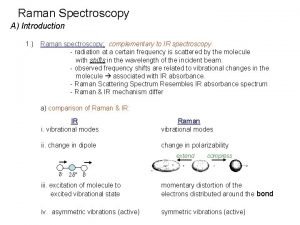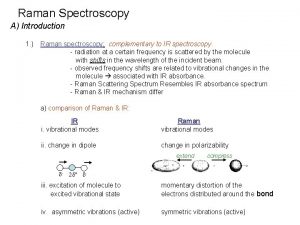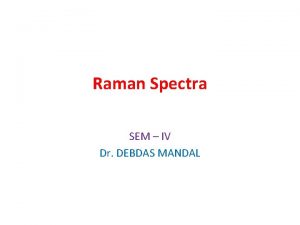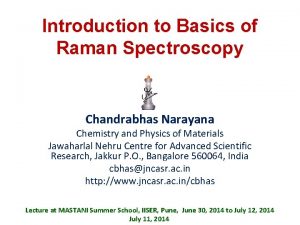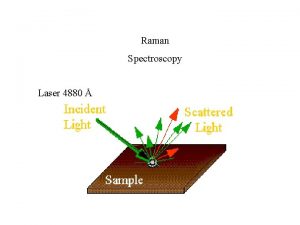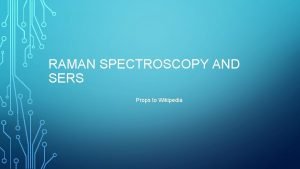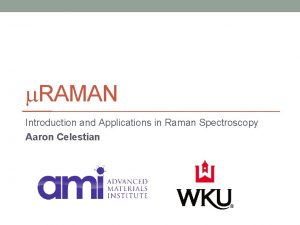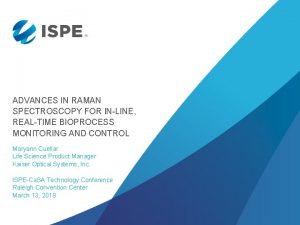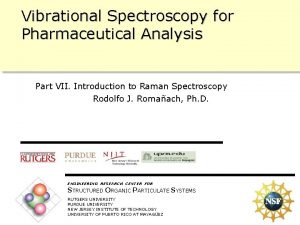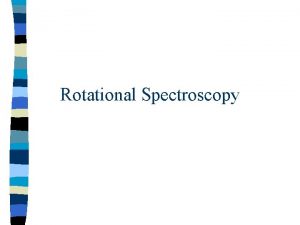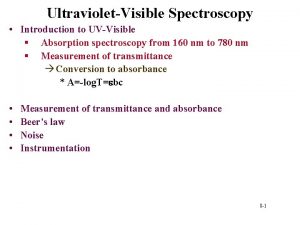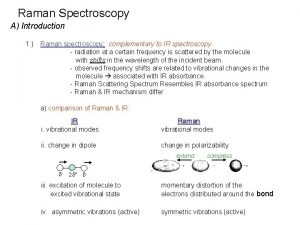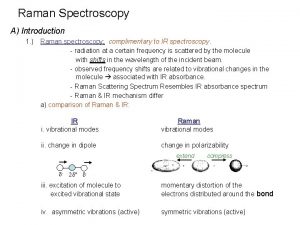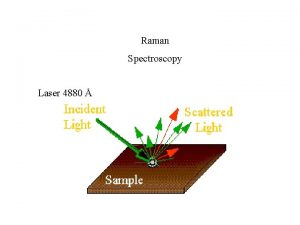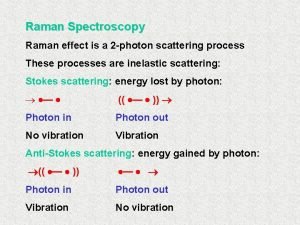Raman Spectroscopy A Introduction 1 Raman spectroscopy complementary











- Slides: 11

Raman Spectroscopy A) Introduction 1. ) Raman spectroscopy: complementary to IR spectroscopy. - radiation at a certain frequency is scattered by the molecule with shifts in the wavelength of the incident beam. - observed frequency shifts are related to vibrational changes in the molecule associated with IR absorbance. - Raman Scattering Spectrum Resembles IR absorbance spectrum - Raman & IR mechanism differ a) comparison of Raman & IR: IR i. vibrational modes Raman vibrational modes ii. change in dipole change in polarizability extend d- compress 2 d+ d- iii. excitation of molecule to excited vibrational state momentary distortion of the electrons distributed around the bond iv. asymmetric vibrations (active)

2. ) Basic Principals of Raman Spectroscopy: - light is scattered by the sample at various angles by momentary absorption to virtual state and reemission No change in electronic states Infinite number of virtual states energy absorbed by molecule from photon of light not quantized

- some scattered emissions occur at the same energy while others return in a different state Rayleigh Scattering no change in energy hnin = hnout Raman Scattering net change in energy hnin <> hnout Elastic: collision between photon and molecule results in no change in energy Inelastic: collision between photon and molecule results in a net change in energy

Two Types of Raman Scattering Anti-Stokes: E = hn + DE Stokes: E = hn - DE ±DE – the energy of the first vibration level of the ground state – IR vibration absorbance Raman frequency shift and IR absorption peak frequency are identical

- Resulting Raman Spectrum Lower energy higher energy Probability of Emission Observed Intensity Raleigh scattering >> Stokes >> anti-Stokes difference in population of energy levels of vibrational transitions Intensity of Raman lines are 0. 001% intensity of the source

3. ) Active Raman Vibrations: - need change in polarizability of molecule during vibration - polarizability related to electron cloud distribution example: O=C=O IR inactive Raman active O=C=O IR active Raman inactive IR & Raman are complimentary. Can be cases where vibration is both IR & Raman active (eg. SO 2 – non-linear molecule) In general: IR tends to emphasize polar functional groups (R-OH, , etc. ) Raman emphasizes aromatic & carbon backbone (C=C, -CH 2 -, etc. ) - Raman does not “see” many common polar solvents can use with aqueous samples – advantage over IR Raman frequency range: 4000 -50 cm-1(Stokes and anti-stokes)

- comparison of Raman and IR Spectra

4. ) Instrumentation: - Basic design i. ) Light source: - generally a laser to get required intensity of light for reasonable S/N • Raman scattering is only 0. 001% of light source - Doesn’t have to be in IR region, since look at changes around central peak. • visible source used because of high intensity • allows use of glass/quartz sample cells & optics • UV/Vis type detectors (photomultiplier tubes)

4. ) Applications: a) Qualitative Information i. characteristic regions for different groups as in IR ii. Raman correlation charts available iii. Good for aqueous based samples iv. Useful for a variety of samples, organic, inorganic & biological b) Quantitative Information – not routinely used i. fewer technical problems than IR, fewer peaks ii. Interference from fluorescence iii. Higher cost iii. Signal weak – require modified Raman methods 1) Resonance Raman spectroscopy allows detection of 10 -3 ->10 -7 M by using lasers light with wavelength approaching electronic absorption 2) Surface enhanced Raman spectroscopy places samples on metal or rough surfaces that increase Raman scattering

Infrared (IR) and Raman Spectroscopy Learning Objectives: A. Understanding Basic principals of IR: a. What is the origin of the IR signal? b. How is the IR signal related to spring theory? c. How is the IR signal related to our understanding of bond dynamics? I. Different types of vibrational modes II. Number of vibrational modes III. What vibrational modes are IR observable? d. How is the IR signal related to the energetics of a bond? I. III. IV. Difference between harmonic and anharmonic Bond dissociation Bond length Relationship between rotational and vibrational energies B. Understanding how to interpret an IR spectra: a. b. c. d. Where are the different bond regions in the spectra Where are the different group regions in the spectra Fingerprint region Quantitative analysis

Infrared (IR) and Raman Spectroscopy Learning Objectives (continued): C. Understanding basic components of an IR spectrometer: a. Light source b. Monochromator c. FTIR D. Understanding how an IR spectra can aid in structure analysis a. Identification of functional groups b. Comparison of fingerprint regions E. Understanding Basic theory of Raman Spectroscopy: a. b. c. d. Difference between IR and Raman Difference between change in vibration and polarization Rayleigh Scattering an Raman Scattering Stokes and anti-stokes
 What is the difference between ftir and raman spectroscopy
What is the difference between ftir and raman spectroscopy Why are raman and ir complementary
Why are raman and ir complementary Difference between ir and raman spectroscopy
Difference between ir and raman spectroscopy Raman spectroscopy basics
Raman spectroscopy basics Selection rules for raman spectroscopy
Selection rules for raman spectroscopy Raman spectroscopy wikipedia
Raman spectroscopy wikipedia Use of raman spectroscopy
Use of raman spectroscopy Raman probe bioreactor
Raman probe bioreactor Raman spectroscopy disadvantages
Raman spectroscopy disadvantages Selection rule for raman spectroscopy
Selection rule for raman spectroscopy Applications of uv and visible spectroscopy
Applications of uv and visible spectroscopy Charge d'un électron
Charge d'un électron
